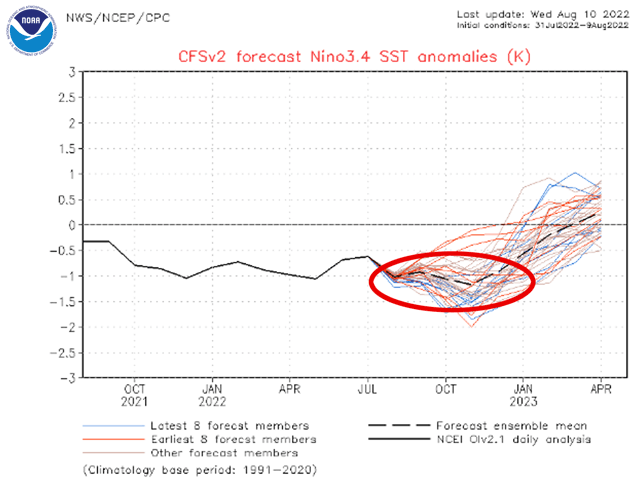Ag Weather Forum
Continued La Nina Unfavorable for Wheat Seeding Moisture
Southern Plains crop areas continue to labor under hot and dry conditions. National Oceanic and Atmospheric Administration (NOAA) July climate reports show Texas had its warmest July, May-to-July and April-to-July on record in 128 years of recordkeeping. Oklahoma's July temperatures were fourth warmest on record. Kansas July temperatures were in the top 20% for warmth. The contiguous U.S. average temperature of 76.4 degrees Fahrenheit was the third warmest on record and 2.8 deg F above average.
The Southern Plains region is also deep in drought. Total drought coverage for the three states of Kansas, Oklahoma, and Texas in early August according to the U.S. Drought Monitor was 91.71%. A year ago, just 2.22% of the region was in drought. Drought is almost entirely in effect in Oklahoma at 99.15%, compared with 1.82% in early August of 2021. Texas has an almost identical situation with 97.11% of the state in drought compared with only 1.10% a year ago. In Kansas, 67.98% of the state is in drought versus 6.19% in early August 2021. But that relatively lower drought coverage also includes 7.65% of the state in Exceptional Drought (D4) on the Drought Monitor. That Exceptional Drought area is entirely in southwestern Kansas. Summer 2022 has evolved into a season which is comparable to 2011 when it comes to hot and dry conditions. The region needs from 9 to 15 inches of precipitation to end the drought.
P[L1] D[0x0] M[300x250] OOP[F] ADUNIT[] T[]
Effects of a robust cool phase La Nina event in the Pacific Ocean get a large share of the responsibility for this situation. The cool ocean water and atmospheric conditions typically lead to a jet stream pattern which bypasses the Southern Plains and allows for a warm and dry combination. This season is certainly illustrative of that impact.
The fall forecast does not offer any change from La Nina influence either. Outlooks through the next 12 months show a 75% to 80% chance of La Nina through the end of the year. La Nina staying around implies continued dryness across the Southern Plains. Such a pattern is unfavorable for soil moisture improvement in what normally is one of the wetter periods of the year. This dry prospect is especially concerning when it comes to available moisture for seeding the next winter wheat crop. Southern Plains winter wheat seeding typically runs from September through November.
Winter wheat is famous for its ability to survive and produce under tough conditions. Considering the current lack of soil moisture and the La Nina-influenced dry outlook for the fall season, that survive-and-advance capability is about to undergo a rigorous test when the long 2022-23 seeding, growth, dormancy, development and harvest cycle finally begins.
Bryce Anderson can be reached at Bryce.Anderson@dtn.com
Follow him on Twitter @BAndersonDTN
(c) Copyright 2022 DTN, LLC. All rights reserved.




